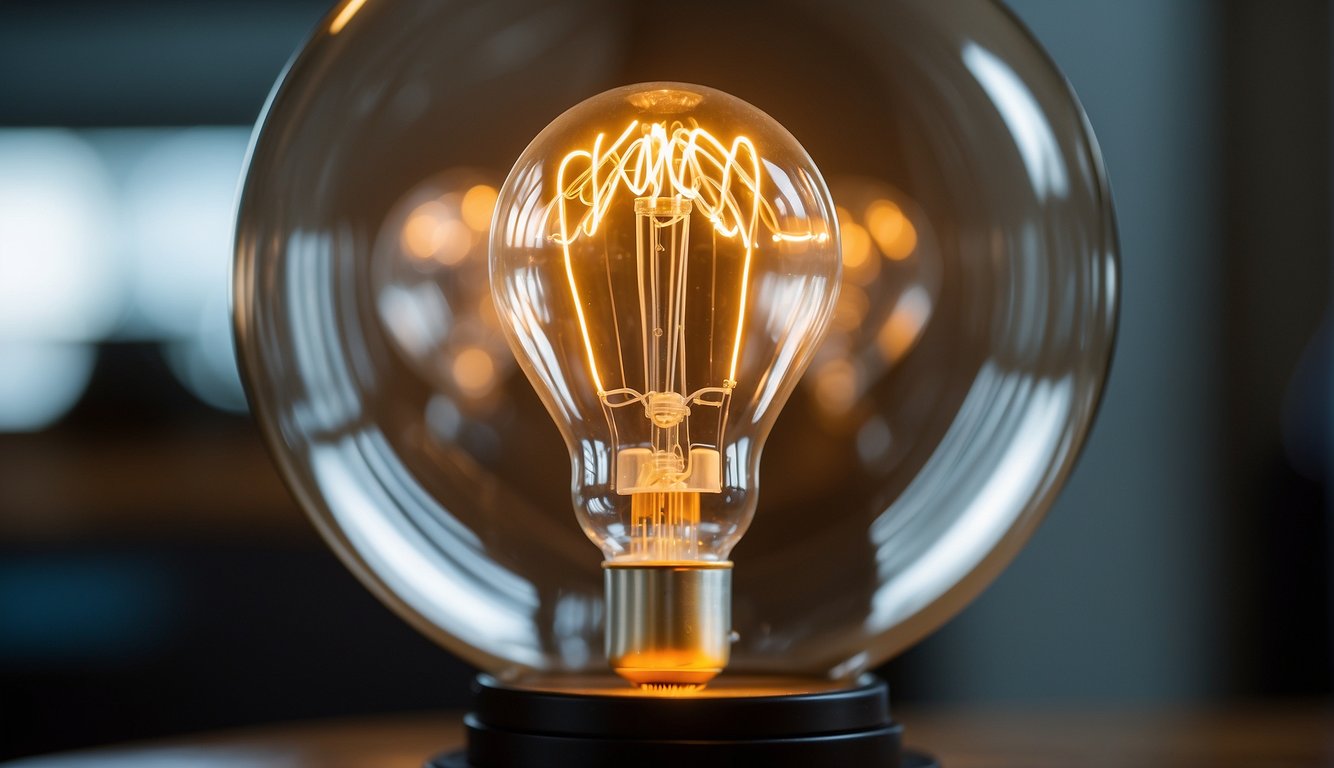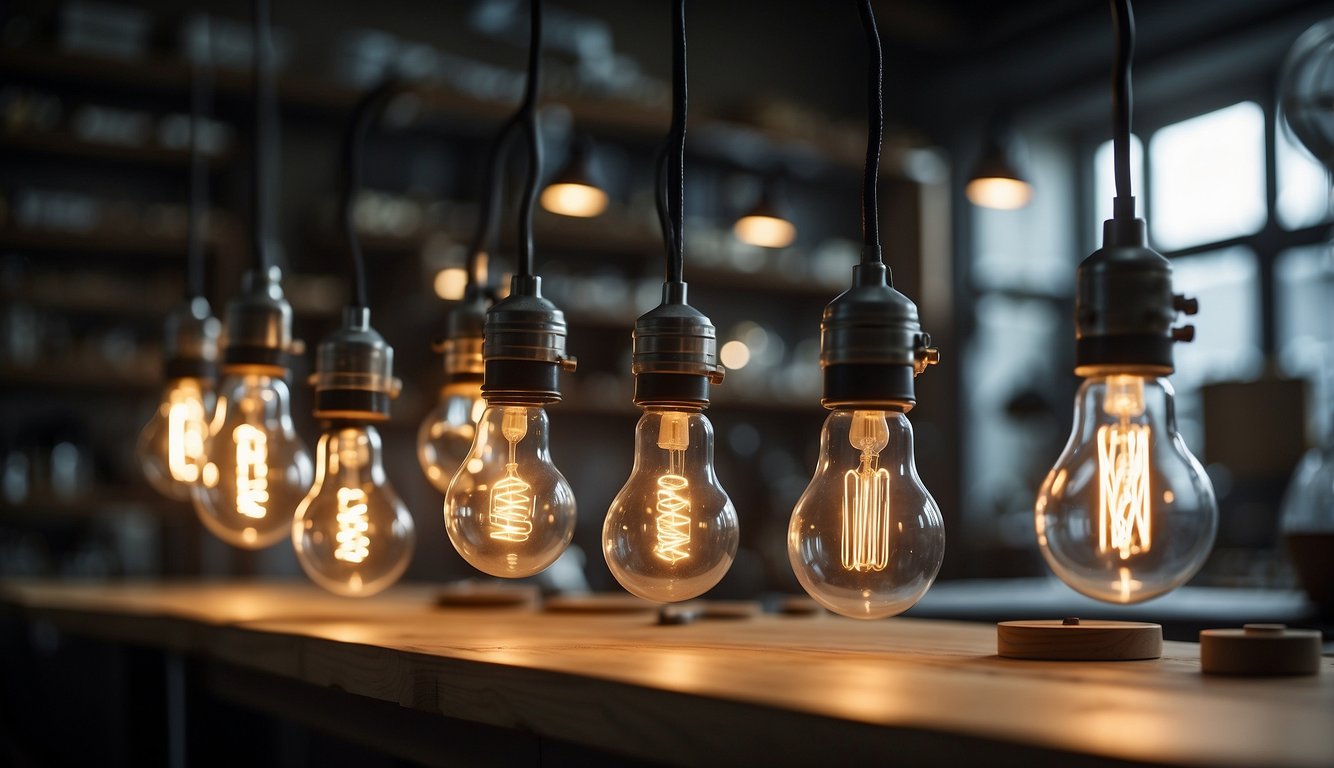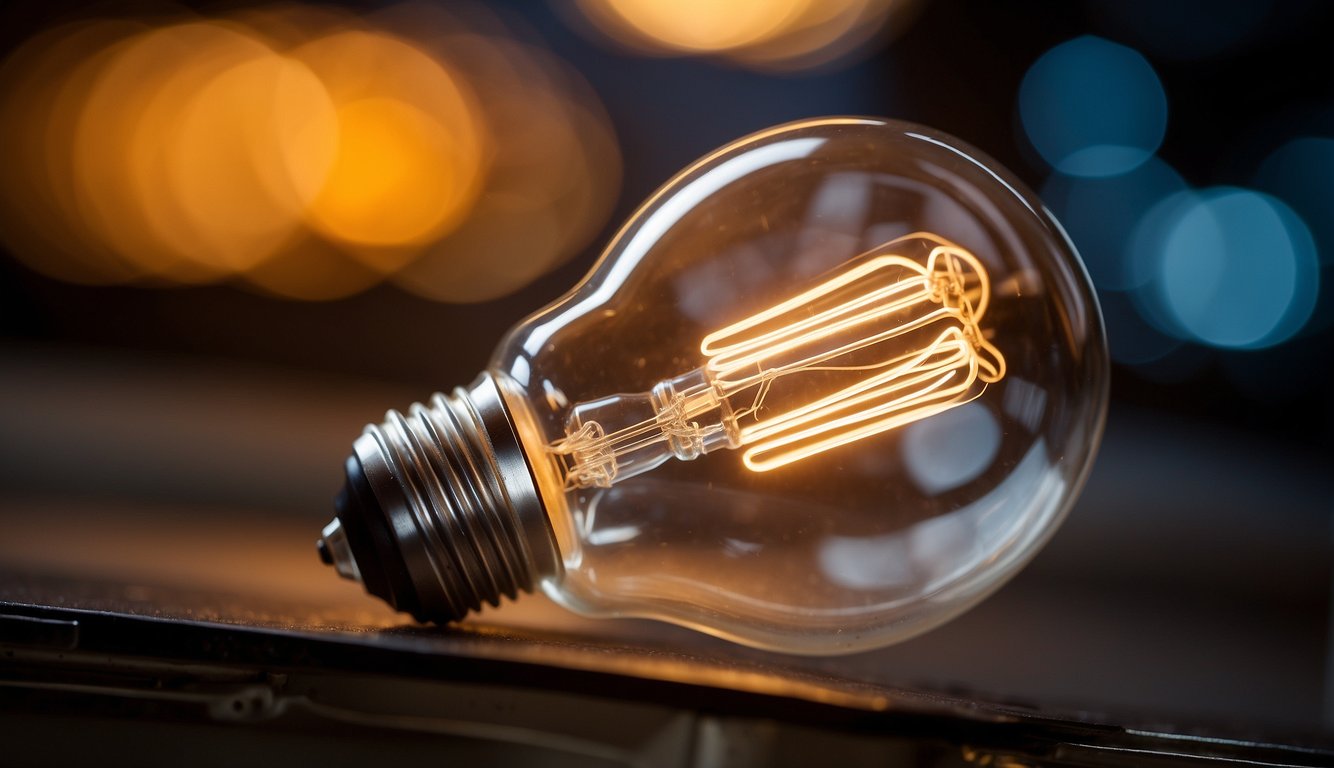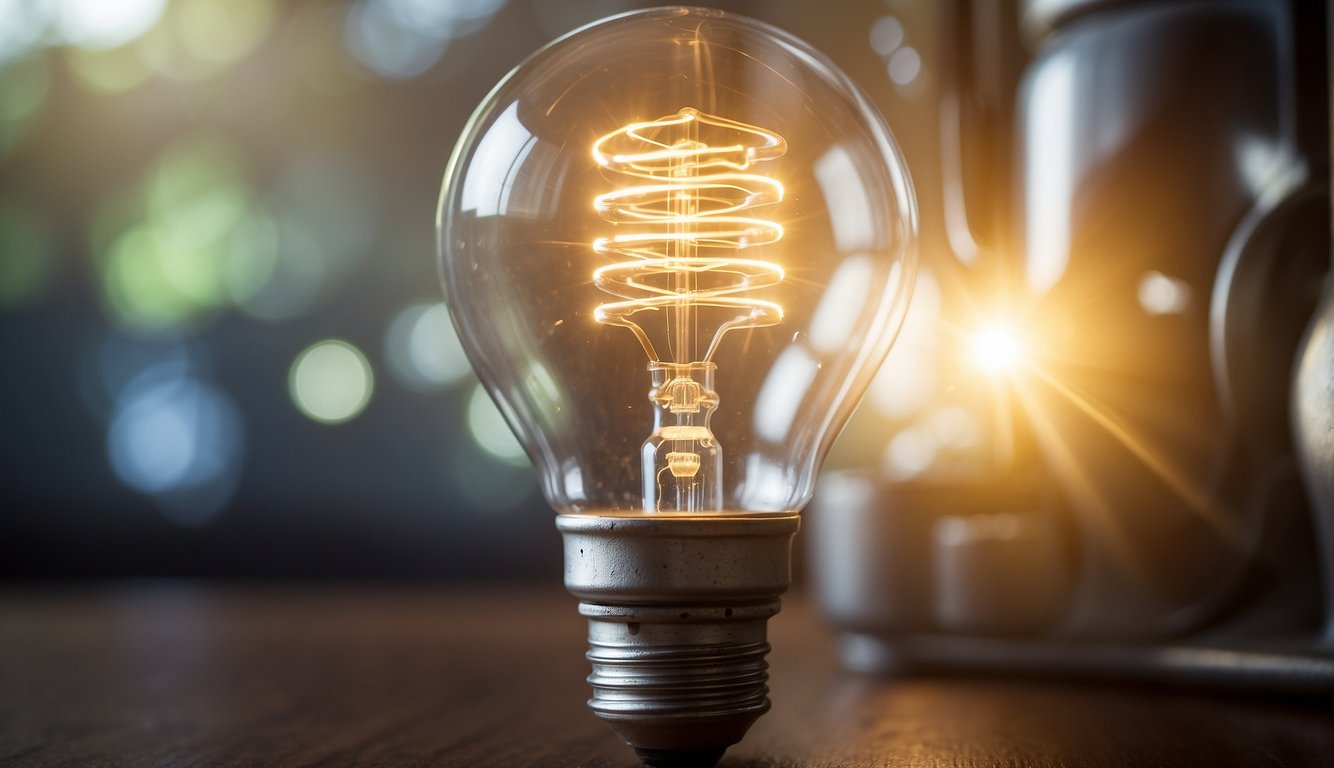Understanding the parts of an incandescent light bulb is essential for recognizing how this ubiquitous piece of technology illuminates the spaces around you. These bulbs, which have been a staple in lighting since their popularization by inventors like Thomas Edison, work by passing an electric current through a wire filament until it glows. While the operation seems straightforward, the intricate design and engineering allow for the effective and consistent production of light.
Incandescent bulbs have seen significant advancements since Thomas Alva Edison’s time, adapting to regulations and evolving with modern innovations in lighting. Still, they maintain basic components, such as the filament, and are filled with inert gases to improve performance. While newer technologies like LEDs are becoming more prevalent, understanding incandescent lighting is valuable, not just for historical context but also to appreciate the foundation of electric lighting that has illuminated generations.
Key Takeaways
- Incandescent light bulbs contain a glowing filament that produces light.
- Regulation and innovation have shaped the modern incandescent bulb.
- They laid the groundwork for advancements in electric lighting.
Historical Development

In your journey through the history of incandescent light bulbs, you’ll encounter a cast of characters, each contributing a novel piece to the puzzle. The narrative stretches far beyond just one man and traces a lineage of invention and refinement. Let’s illuminate the early sparks of genius and Edison’s eventual breakthrough.
Early Innovators
The story of the incandescent lamp begins with Humphry Davy. In 1802, Davy created the first electric light by passing a current through a platinum strip—platinum being chosen for its high melting point. Decades later, others like Henry Woodward and Mathew Evans built upon Davy’s work but struggled to commercialize the technology.
Edison’s Contribution
Thomas Edison, while not the sole inventor of the incandescent bulb, was critical in improving the design for mass use. In 1879, Edison developed a high-resistance carbon-filament bulb lasting up to 1,200 hours—a significant leap forward. But Edison’s success wasn’t a solo feat; Lewis Latimer, an African American inventor, later joined Edison and patented a carbon filament manufacturing process that was more efficient. Around the same time across the Atlantic, Joseph Wilson Swan independently devised a durable carbon filament bulb. Swan’s and Edison’s pursuits would converge, marking a turning point towards lighting up the modern world.
Basic Components
https://www.youtube.com/watch?v=II8Ri1eAUVQ&embed=true
When you flip a switch and the incandescent light bulb above head brightens the room, it’s worth knowing the basic parts that make this possible. These components are elegant in their simplicity, working together to produce light.
Glass Enclosure
The glass bulb, or your light bulb’s outer shell, serves both protective and functional roles. It shields the delicate internal elements and contains an inert gas to prevent the filament from burning out too quickly.
Filament Types
At the heart of your bulb is the filament, commonly made of tungsten because of its high melting point. Older types used a carbon filament, but these have largely been replaced. When electric current passes through, the filament heats up and glows, illuminating your space.
Electrical Contacts
Lastly, electrical contacts are essential, as they’re your light bulb’s connection to the power source. The metal base at the bottom is designed to fit snugly into your light bulb socket, while the internal wires and stem securely hold the filament in place and provide it with electricity.
Working Principle
https://www.youtube.com/watch?v=R0qY8IeWrFA&embed=true
When you turn on an incandescent light bulb, the magic happens quite simply: electrical energy is transformed into light. But how does this process occur? Let’s break it down to better understand.
Electrical to Light Energy
Electricity, when supplied to the light bulb, travels through the metal base to a tightly coiled wire known as the filament. This filament is the heart of your incandescent bulb. As electric current flows through the filament, which is commonly made from tungsten due to its high melting point, the electrical energy changes to both heat and light energy. The transformation of electrical energy to light energy occurs because the electric current excites the filament’s atoms, causing them to release photons, which are little packets of light.
Heat Production
While producing light, a significant amount of heat is generated in the bulb. It’s actually the heat that warms up the filament to such an extent that it glows, producing visible light. However, not all the electrical energy becomes visible light; a large portion converts into heat, which is why incandescent bulbs are less energy-efficient compared to other lighting technologies. The glass bulb surrounding the filament gets warm but doesn’t melt because it’s designed to withstand the high temperatures.
Physical Properties
« Most Healthy Light Bulbs: Choosing the Best for Your Well-being
Parts of Light Bulb Holder: A Guide to Components and Functions »
When you look at an incandescent bulb, you’re looking at one of the simpler forms of electrical light sources, but it’s the materials within that determine its performance and durability.
Melting Points
The melting point of a material is crucial in light bulb construction since it dictates how much heat the bulb can withstand before it starts to deform or fail. In your incandescent light bulb, the filament is typically made from tungsten due to its exceptional high melting point of about 3422°C (6192°F). This allows the filament to get extremely hot and emit light without melting.
Structural Integrity
To maintain structural integrity, the tungsten filament is encased in a glass bulb which is either left as a vacuum or filled with inert gases like argon or nitrogen. This environment helps to prevent the tungsten filament from deteriorating too quickly. The bulb’s ability to handle high temperature fluctuations without cracking is partially due to the thermal properties of the glass and the protective atmosphere created by the inert gas inside.
Gas Fillings
https://www.youtube.com/watch?v=wzxYHtR2l3o&embed=true
When you switch on your incandescent light bulb, you’re not just lighting up a filament; you’re activating a carefully engineered atmosphere within the bulb. Inert gases, like argon, krypton, and xenon, are key players in preserving the longevity and performance of the filament.
Role of Inert Gases
Why are inert gases used instead of just leaving a vacuum within the bulb? The answer lies in their ability to protect the filament. These gases prevent rapid oxidation and evaporation of the filament, which would otherwise lead to a shorter lifespan for the bulb. An inert gas environment allows the filament to glow brightly without degrading quickly.
Specific Gas Types
- Argon: This is the most commonly used gas due to its cost-effectiveness and ability to increase the lifespan of the bulb. It’s a type of noble gas that enhances the efficiency of the light bulb.
- Krypton: Although more expensive, krypton-filled bulbs offer a brighter light and are more efficient than those filled with argon alone.
- Xenon: This gas is less common in standard incandescent bulbs but provides a bright light with excellent color rendering.
Each gas type contributes to the desired characteristics of the incandescent bulb, balancing cost and performance to meet your lighting needs.
Performance Metrics
When you’re considering a light bulb, specific performance metrics can give you a good idea of its efficiency and longevity. Key attributes like how much light the bulb produces and how long it lasts make a big difference in both your energy bills and how often you need to replace them.
Luminous Efficiency
Luminous efficiency is a vital metric that measures the amount of light produced per unit of power consumed. You’ll see this represented by lumens per watt. A higher value signifies a more energy efficient bulb, meaning you get more brightness for less electricity used. For instance, incandescent bulbs typically have a luminous efficiency ranging from 10 to 17 lumens per watt.
Lifespan and Durability
The lifespan of a light bulb is measured in hours and indicates how long you can expect the bulb to last before it needs to be replaced. On average, an incandescent bulb’s lifespan is about 1,000 hours. Regarding durability, it’s also useful to note that incandescent bulbs are relatively fragile and can break or burn out more easily compared to other types, like LEDs.
Color temperature, measured in Kelvins, doesn’t directly affect the lifespan or energy efficiency, but it does determine the color of the light—from warm yellowish hues to cool bluish tones. It’s essential to choose a color temperature that suits the mood and function of your space.
Comparative Analysis
https://www.youtube.com/watch?v=KnKG-5TEzUk&embed=true
In this section, you’ll discover how incandescent bulbs stack up against their more modern counterparts, specifically LED and CFL bulbs, in terms of energy efficiency and other key features.
Incandescent vs LED
When comparing an incandescent bulb to an LED bulb, the difference in energy efficiency is quite stark. LED bulbs use up to 90% less energy than traditional incandescent bulbs. For example, a 60-watt incandescent bulb can be replaced by a 7-10 watt LED bulb to produce a similar amount of light, revealing the advancement in energy efficiency of LED bulbs. Additionally, LEDs have a longer lifespan, often lasting upwards of 25,000 hours compared to the 1,000-hour average lifespan of incandescent bulbs.
Incandescent vs CFL
Comparing incandescent bulbs to CFLs (compact fluorescent lamps), a 60-watt incandescent can be substituted with a 13-15 watt CFL to get the same amount of lumens. A standout fact is that CFLs consume about a third of the energy of incandescent bulbs. With a life expectancy of roughly 8,000 hours, CFL light bulbs offer a considerable durability advantage over incandescents. However, they don’t outperform LEDs in either energy efficiency or lifespan.
Modern Innovations
https://www.youtube.com/watch?v=cDZX0aBBCLo&embed=true
In the quest for energy efficiency and enhanced functionality, the lighting industry has made significant strides. You’ll find materials have evolved and smart technologies have integrated seamlessly into lighting solutions.
Advancements in Materials
Tungsten Filaments: The heart of traditional incandescent bulbs has seen improvements. Modern halogen lights, for example, use tungsten filaments but with a twist. They are encased in a smaller quartz envelope with a halogen gas, allowing them to burn hotter and brighter, which increases both efficiency and lifespan.
LED Materials: LEDs signify a leap forward, swapping out filaments for semiconductors. These materials produce light when an electric current passes through them, with LED light bulbs being far more energy-efficient and longer-lasting than their incandescent precursors.
Smart Lighting Technologies
Smart Lighting: Here’s where you take control of your home lighting with a tap on your smartphone. Innovative features like dimmers and color-changing abilities can be adjusted to fit the mood or task at hand.
Commercial Lighting: In commercial spaces, LED technology isn’t just about illumination; it’s a smart business move. Energy-efficient LEDs paired with smart systems reduce costs and improve environmental footprints. Your office can now adapt lighting based on occupancy or time of day, thanks to smart sensors.
Remember, your choices in lighting don’t just brighten your space; they’re a reflection of cutting-edge innovation shaping your day-to-day life.
Usage and Applications
In your home or business, incandescent bulbs play a pivotal role in illumination. They’re not just sources of light; they influence the ambiance and functionality of your spaces. Here’s how you effectively use these bulbs in different settings.
Residential Lighting
You’d typically find incandescent bulbs in table lamps and ceiling fixtures within your home. They create a warm, inviting atmosphere with a soft glow that’s comfortable for the eyes. Even though the energy consumption is higher compared to LEDs or CFLs, their simplicity and historical prevalence in residential settings have made them a longstanding choice for many house owners. When you’re selecting incandescent bulbs for your home, you prioritize comfort and aesthetic appeal.
-
Portable Lighting: In flashlights or other battery-operated lamps, incandescent bulbs are valued for their instantaneous brightness and portability.
-
Decorative Purposes: For a cozy and intimate feel, incandescent lamp shades are often used in bedrooms and living areas where the quality of light is as important as its function.
Industrial and Commercial
In commercial and industrial environments, incandescent bulbs are often used for both practical and aesthetic purposes.
-
Task Lighting: In industrial settings, these bulbs provide bright, direct light for tasks requiring fine attention to detail.
-
Signage and Advertising: Businesses employ incandescent bulbs in advertising lighting due to their brightness and visibility, making promotions and signs eye-catching, especially at night.
Remember, the energy consumption of incandescent bulbs is something to consider when you’re selecting lighting for frequent or prolonged use in commercial settings. Although they are being phased out in favor of more energy-efficient lighting options, their straightforward design and the warm quality of light continue to find specialized applications in various industries.
Regulations and Impact
https://www.youtube.com/watch?v=RUsGkJyEXqg&embed=true
Your understanding of incandescent light bulbs is about to get clearer, especially when it comes to environmental implications and legislation. Learn how regulations have altered their usage and what impact this has on energy conservation efforts.
Environmental Considerations
Incandescent light bulbs have been widely used, but they’re not the most energy-efficient options available. Here’s why: Traditional incandescent bulbs convert less than 10% of the energy they consume into visible light, with the remainder generating heat. This inefficiency prompted a shift towards more sustainable lighting solutions. The phase-out of these bulbs has been a step toward reducing energy consumption and, consequently, mitigating their environmental impact. Transitioning to energy-efficient alternatives helps you contribute to this cause while potentially reducing your monthly electricity bills.
Legislation
In 2007, the Energy Independence and Security Act set the stage for a massive shift in the lighting industry, focusing on the phase-out of inefficient light bulbs. This legislation didn’t just impact incandescent bulbs; it marked a push for more energy-efficient lighting throughout the U.S. Newer standards have been implemented, leading to a gradual phase-out of standard incandescent and halogen bulbs, making way for their energy-efficient counterparts like LEDs and CFLs. This transition has reshaped the market, with new regulations from the Department of Energy ensuring that all general service lamps, including your everyday light bulbs, meet strict efficiency criteria. By choosing compliant bulbs, you’re aligning with these regulations and supporting national goals for energy conservation.





